Learn Shopify Dropshipping With This Ultimate Guide
Contents
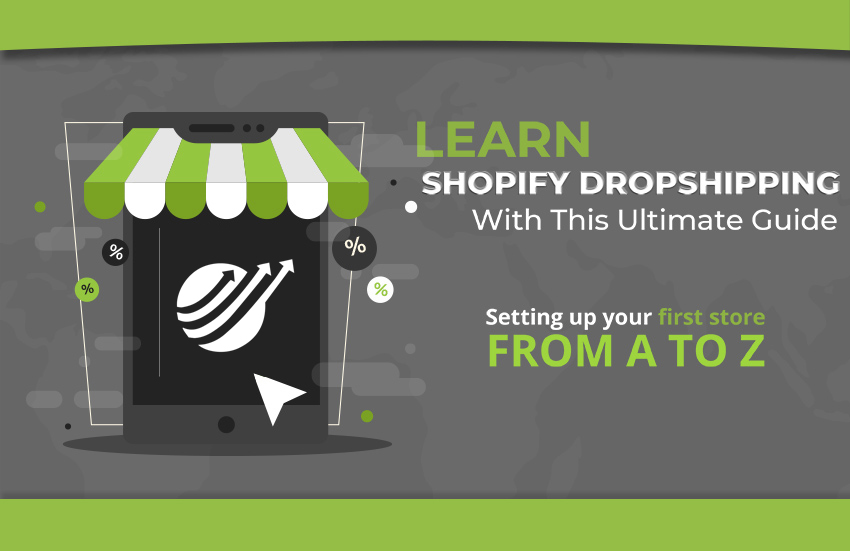
Dropshipping. It’s probably the thing you’ve been hearing about the most over the past year, a guaranteed and super awesome way to make money online. You’ve heard all these success stories of entrepreneurs who’re making big bucks dropshipping online and want to get in on the action, but have no idea what dropshipping is or where to begin.
Well, you need not worry because not only will this ultimate guide tell you all you need to know about what dropshipping is but will also walk you through the surprisingly simple process of setting up your own online store – entirely from scratch!
What is Dropshipping?
As an entrepreneur who wants to make it big in ecommerce, but does not have the resources to finance, manage and set up manufacturing, supply chains, and distributions, dropshipping is the best way to go. Why? Because it does away with all of the inventory management strains!
As a dropshipper, you need not have any inventory in stock. Instead, all your store’s orders are simply sent to the third party (your suppliers) and they ship the products directly to the customers. You don’t even have to touch the product!
Dropshipping is so amazing because it’s so incredibly simple to set up and manage. You don’t need a ton of cash as an up-front investment and you don’t even have to do it full-time. Sounds great, doesn’t it? Keep reading to learn how you can use Shopify to set up your website, source products and start selling in only a couple of days!
What’s so special about Shopify?
While there are a lot of ecommerce platforms out there that you can choose to power your dropshipping business, Shopify is by far the simplest and most popular option out there. It is the largest ecommerce platform out there, with over half a million entrepreneurs that use it to run their businesses online.
There are four basic reasons why Shopify is so popular with entrepreneurs and why you should use it to set up your drop shipping business.
- Simplicity: This is probably the biggest advantage that Shopify offers. Despite being a feature-packed and powerful platform, Shopify does not require any prior technical knowledge. The creators of this platform have made sure that it simply doesn’t get overwhelming for users.
- Feature-packed: Shopify has more features than any other ecommerce platform out there. Not only does it let your create your online store (not just a website, like most other platforms), but also has a host of features that will help you run it, like managing sales, marketing and accounts. What’s even more incredible is that Shopify comes with a host of apps that supplement it, so if you’re looking for a feature that’s not available, you can simply find an app that does it and link it to your store!
- Trust: As an entrepreneur, you probably have a lot riding on your dropshipping start-up and need a platform you can trust. Shopify is great in this regard because you can count on it to not crash or fold, especially during the biggest holiday and shopping seasons!
- Dropshipping-friendly: Lastly and most importantly, Shopify is probably the most dropshipping friendly platform available – it’s full of solutions that have been designed specifically for dropshipping alone!
In essence, Shopify is the chassis that you can build your dropshipping business on. It provides you with all the tools that you need to design and set up your store, and does away with the need for a separate hosting service and extra fee. All you need to do is pay Shopify’s quite reasonable monthly fee and focus on the important part of your business – sales!
Now that you know the advantages of dropshipping with Shopify, we can move on to the next section in this guide.
How to start Dropshipping – finding your Niche
Before you begin selling products to your customers, you need to know what those products and who those customers are going to be. This will be your niche – the section of the market you plan to target.
There are multiple ways you can find your niche, and everyone has a different opinion regarding the best way to do this. What you really should do, however, is choose a niche that you are interested in, or passionate about, but make sure that it has market demand.
Remember that the ultimate purpose here is to make money by selling items people are interested in and you need to choose a niche that is in demand. To do so, you’ll need to carefully research the market in terms of the popularity, demand and profitability of your specific niche. You need not worry. All you need to do is follow the steps below to find out how profitable your niche is!
Step 1: Keyword Research
To begin, you need to identify and make a list of all the potential product keywords in your specific market. For example, you could be interested in the whole wearables and smart watch niche, so you will need to brainstorm the keywords people would search for. Your list will most likely include keywords such as “Fitness Trackers”, “Smart Watch”, “Fitbit”, “Heart Rate Monitor” etc.
Once your list is complete, you will need to enter all of these terms into Google’s Keyword Planner to find out how many searches each is getting. We can see below that “Fitbit” and “Mi Band” are getting the most searches.
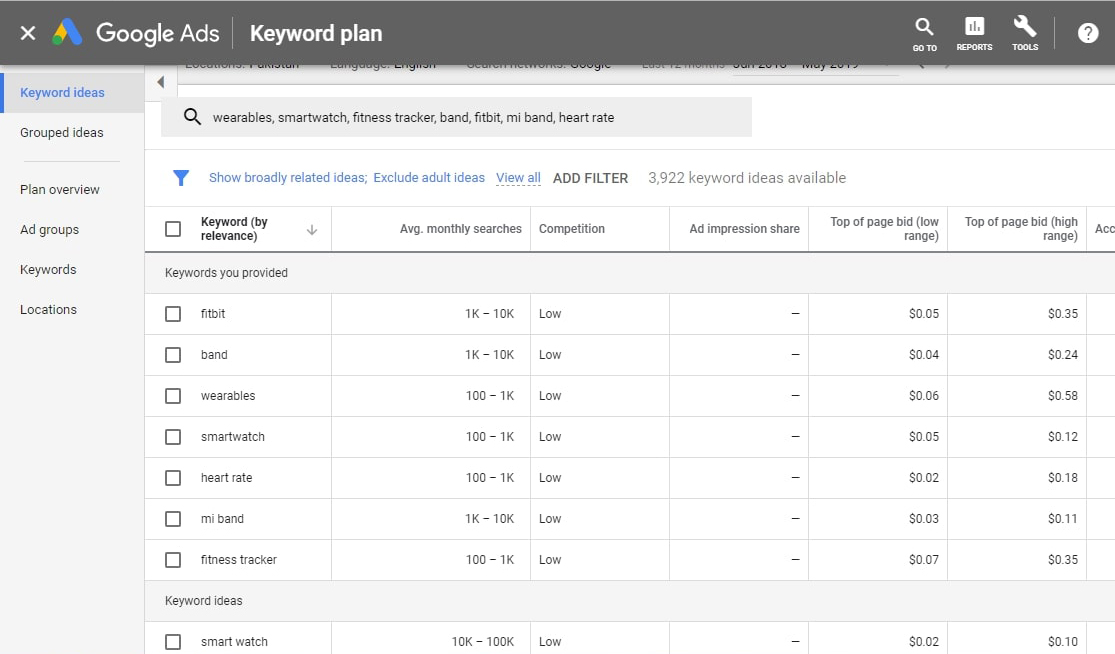
Step 2: Trend Analysis
Keyword popularity can only tell you so much. What you actually need to know is whether these items are gaining or losing popularity. To find this trend data, we turn to Google Trends and see what it can tell us.
We can see that the Xiaomi Mi Bands seem to be gaining popularity and if you were to start dropshipping wearables, would be a great product to sell. We can now move on to the next step.
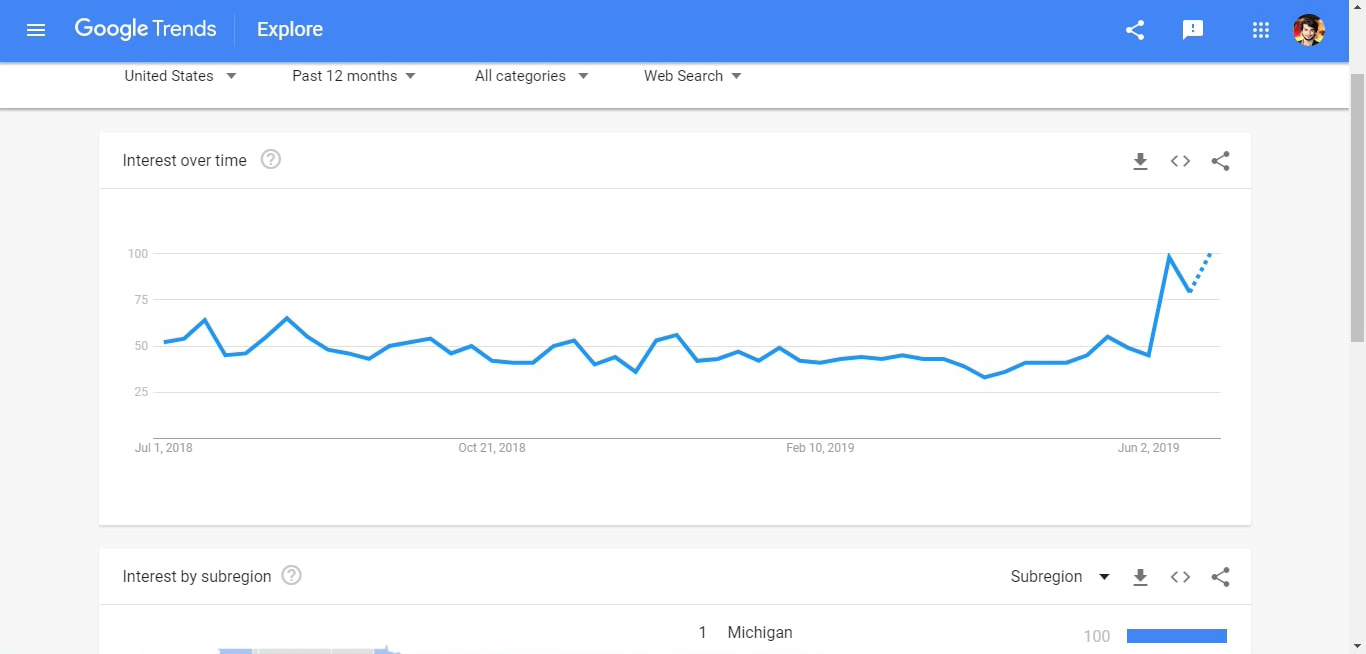
Step 3: Niche profitability
While it’s great that the product you want to sell is popular, you need to make a profit when you sell it. Before you can start your business, you need to find out if your products will actually make you any money or not.
The best way to do this is to run some quick numbers. To be successful at dropshipping you need a nice and healthy profit margin. An ideal margin of about 40-70%, or even higher, is great because now you can easily cover costs such as marketing, shipping, Shopify fee and more.
So basically what you need to look for are low-cost products that you can sell for much more. The easiest way to do this is to look for the products you want to sell on marketplaces like AliExpress and Oberlo. Then, you can check what they’re selling for in retail stores, and set your prices accordingly. A great tool you can use to calculate your profit is the Shopify Gross Profit Margin Calculator!
Setting up your Shopify Dropshipping Store – Complete Guide
Once you’ve researched your niche and know which products you want to sell, you’re ready to jump in and start building your store. This guide will take you through the entire process in 10 easy steps. You can start by watching this video as it will go through a lot of the steps described below.
Step 1: Pick a Name
The first thing your store needs is a name. The reason it is so important is that a name is the most powerful factor of a brand, and you need to think carefully about what you want to name your store. The best brand names are simple, creative and memorable.
Once you’ve decided on a name you like, make sure no one else is using it. To check, simply Google the name and see if any websites come up. If not, then you’re in luck and you can now proceed to the next step!
Step 2: Create your Shopify Account
Creating a Shopify account is really simple. Just visit Shopify.com and enter your email address in the given empty field.
Click the “Get Started” button, which will take you to a form where you will need to create a password for your account and enter the name you’ve picked out for your Shopify dropshipping store.
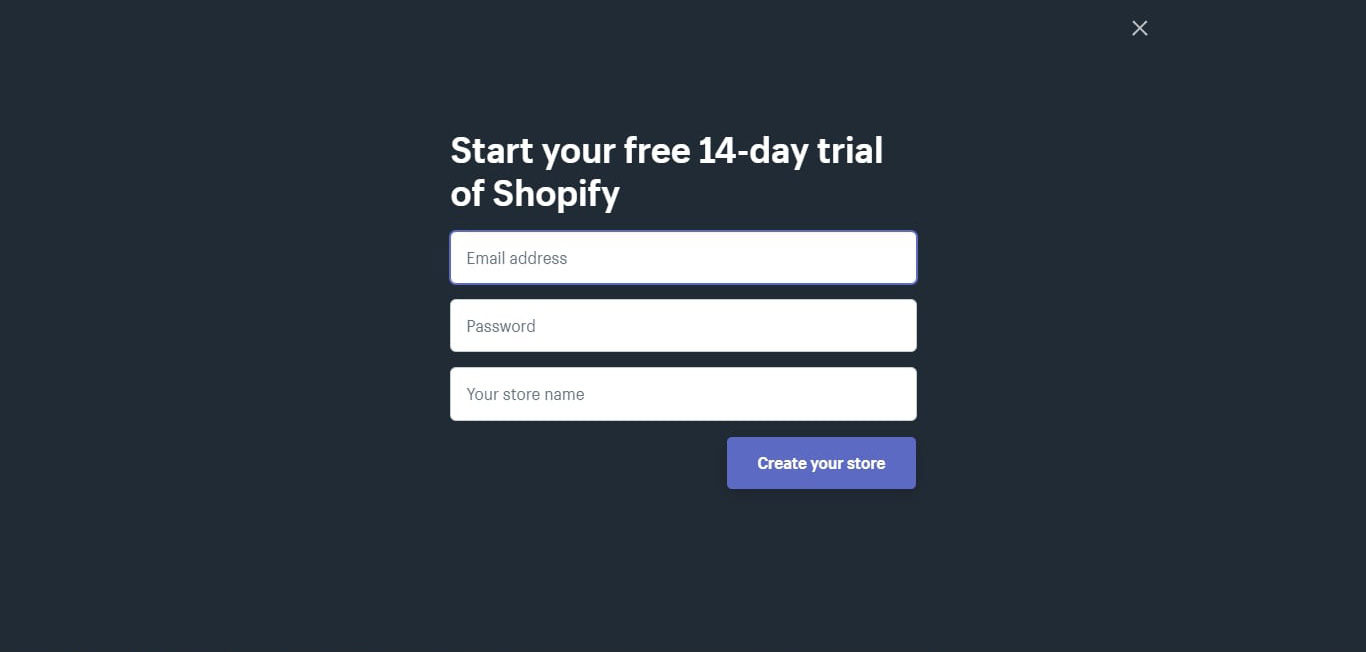
Once that is done, Shopify will ask you a few questions like where you’re located and if you’re already a seller, etc. When you’re finished, Shopify will take you to your store’s backend. This is where all your controls are, so it’s important to remember your backend URL. Shopify will email it to you and you can bookmark it, but it’s a fairly easy format to remember: YOUR-STORE.myShopify.com/admin
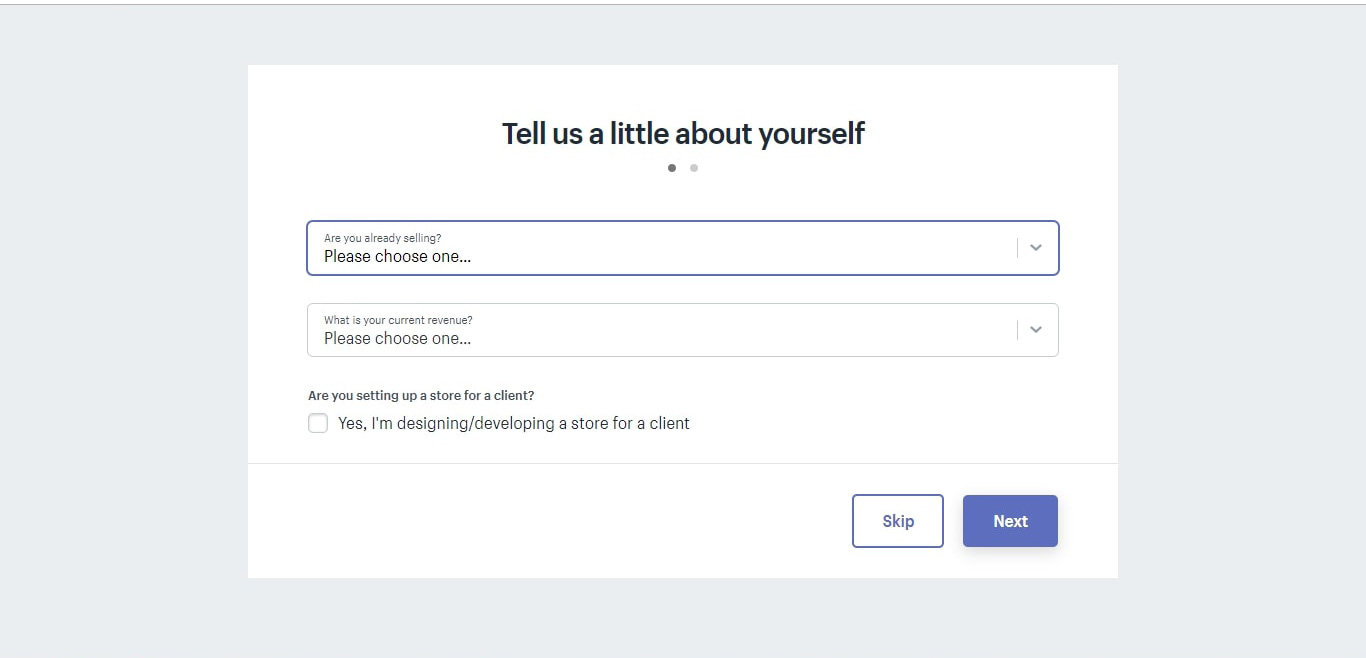
Step 3: Adding Products
Now that you’re done setting up your account, you’re at your store’s backend, or the Shopify dashboard. This is your command center and at this point, you can start doing a number of things like designing your store, adding products or setting up payment information, etc. Check out this video on how to start adding your first
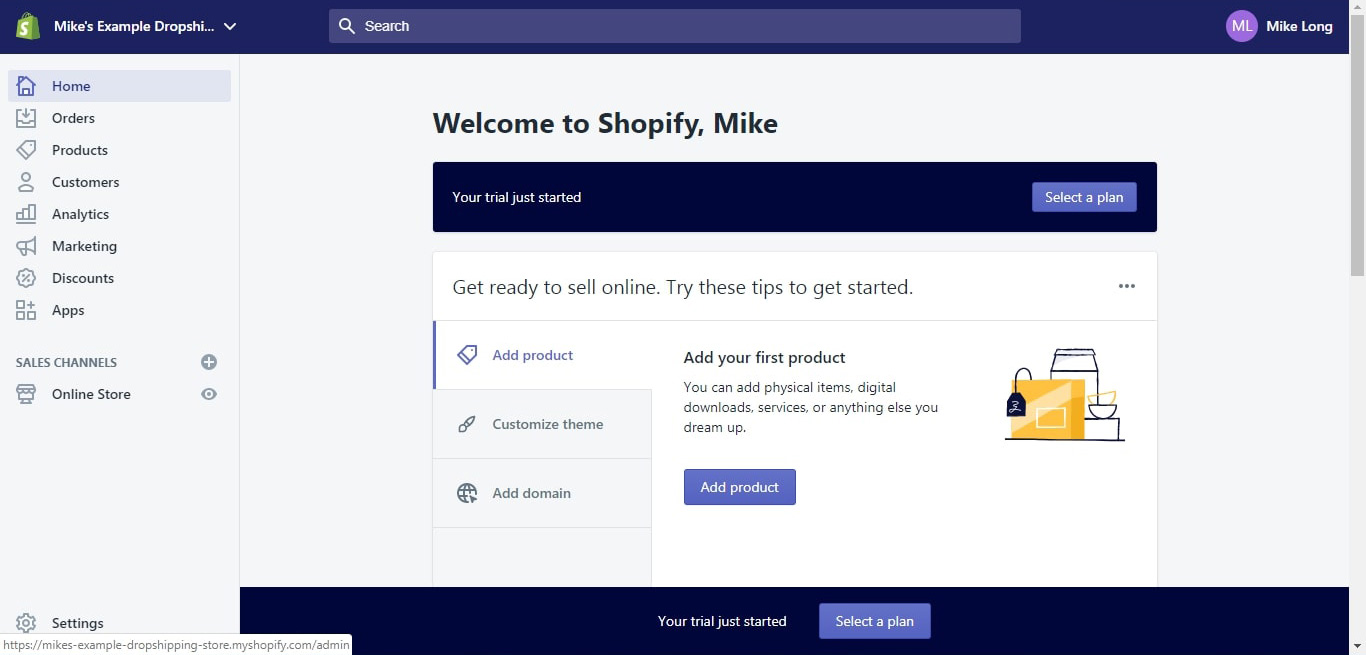
We’ll begin with adding products first. Why, you ask? The reasons are simple. Adding products first is the most effective way of getting started with setting up your store. With Shopify, it takes only minutes to add products to your store, and the entire experience is so simple that it gets you going and helps in building momentum. Adding products first also makes designing your store later much easier. You can then design your store around the products you have in stock, without having to imagine how the empty design would like with specific products.
Adding products (using Oberlo)
Oberlo is Shopify’s default dropshipping app, and it’s very simple to add products using it. While you can add products from any vendor you prefer, and we will be looking at a few great dropshipping companies later on, Oberlo is a great example. Here’s how you can add products:
1. Click on the “Products” tab on the left hand side on your dashboard.
2. In the “Insert” dropdown, select “More actions”, and then click “Find more products to sell”.
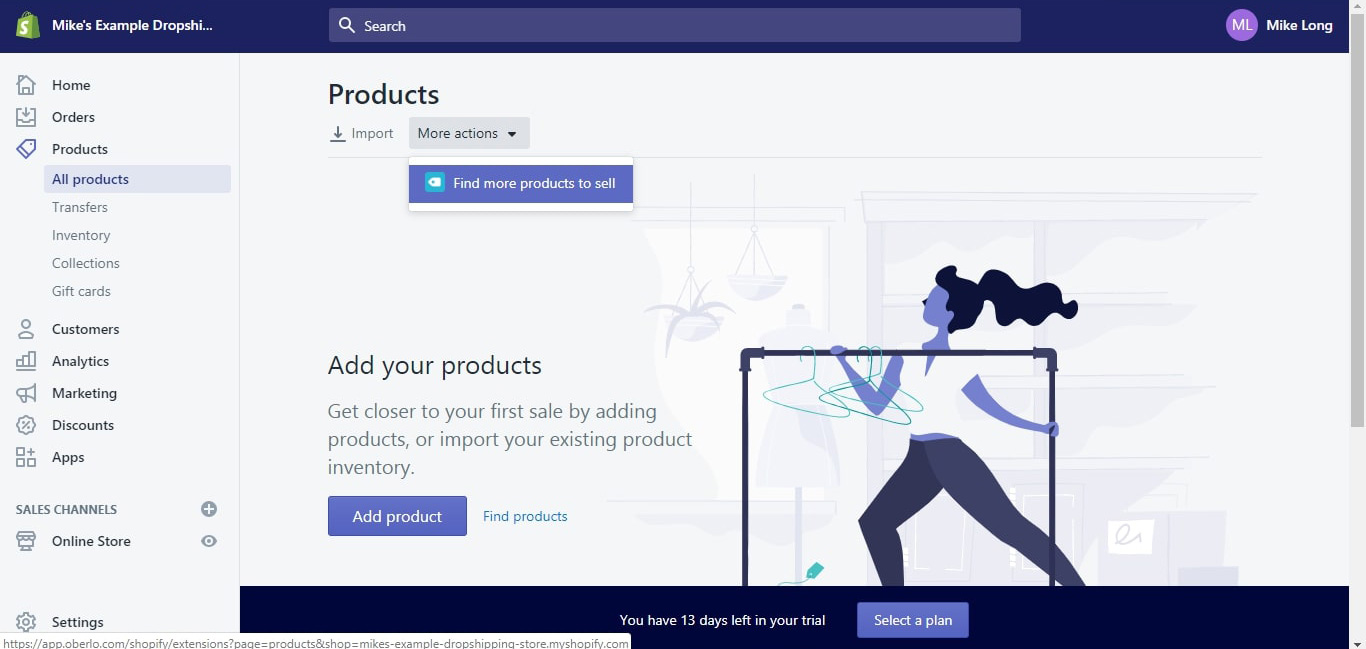
3. This will open up Oberlo’s interface, where you can search for the products you want to dropship and their suppliers. Simply, enter your products into the search bar.
4. Browse through the listed products and once you find something you like, simply click the “Add to import list” button.
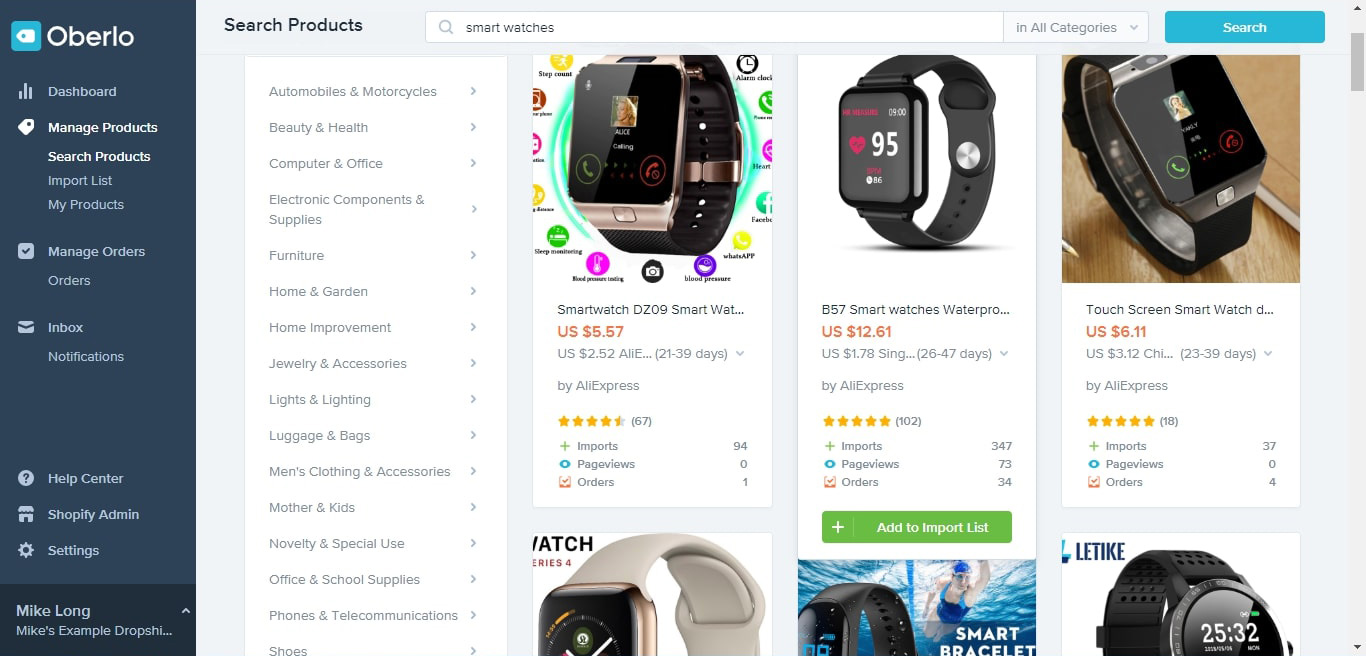
5. This will take you to the product page, where you will be able to see prices and shipping costs. You can now add your retail price based on these. Once you’re done, simply click “Add product” to add these products to your Shopify dropshipping store.
6. You can select as many products as you like – simply repeat steps 3-5.
Step 4: Editing Products and Adding Collections
Now that you’ve added all the products you want to sell, you need to navigate back to your dashboard. Here, you will see all of the products you’ve added from Oberlo. What you should do at this stage is togo through each item and edit their titles and descriptions. You don’t want to keep the same details as the supplier because these are stuffed with keywords and aren’t appealing. You need to keep your target market in mind when making these edits.
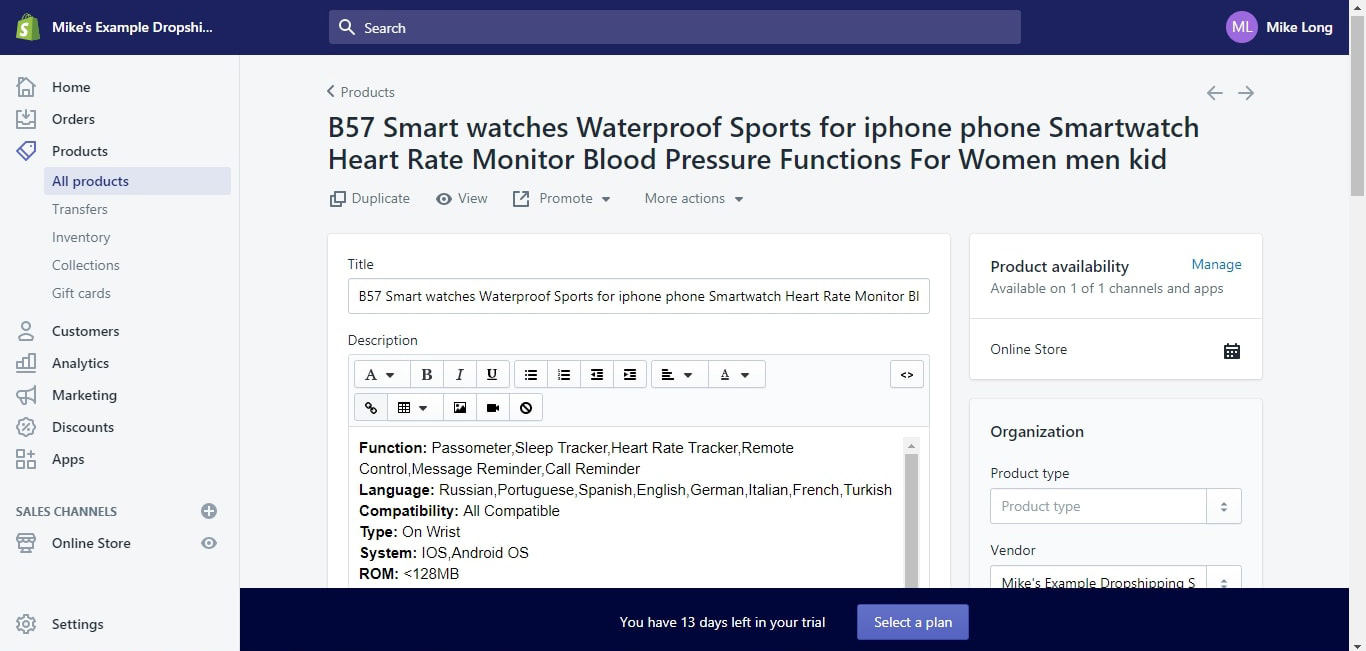
You should also add product tags to each item at this stage. Tags help in labelling and categorizing items. For example, if you intend to sell accessories, then your tags can be “Wallets”, “Bracelets”, “Casual”, “Steam punk”, “Stainless steel” etc. Adding tags is simple, and you can either do it individually on each product page, or add tags in bulk to your products using the “Add tags” option in the “Actions” tab.
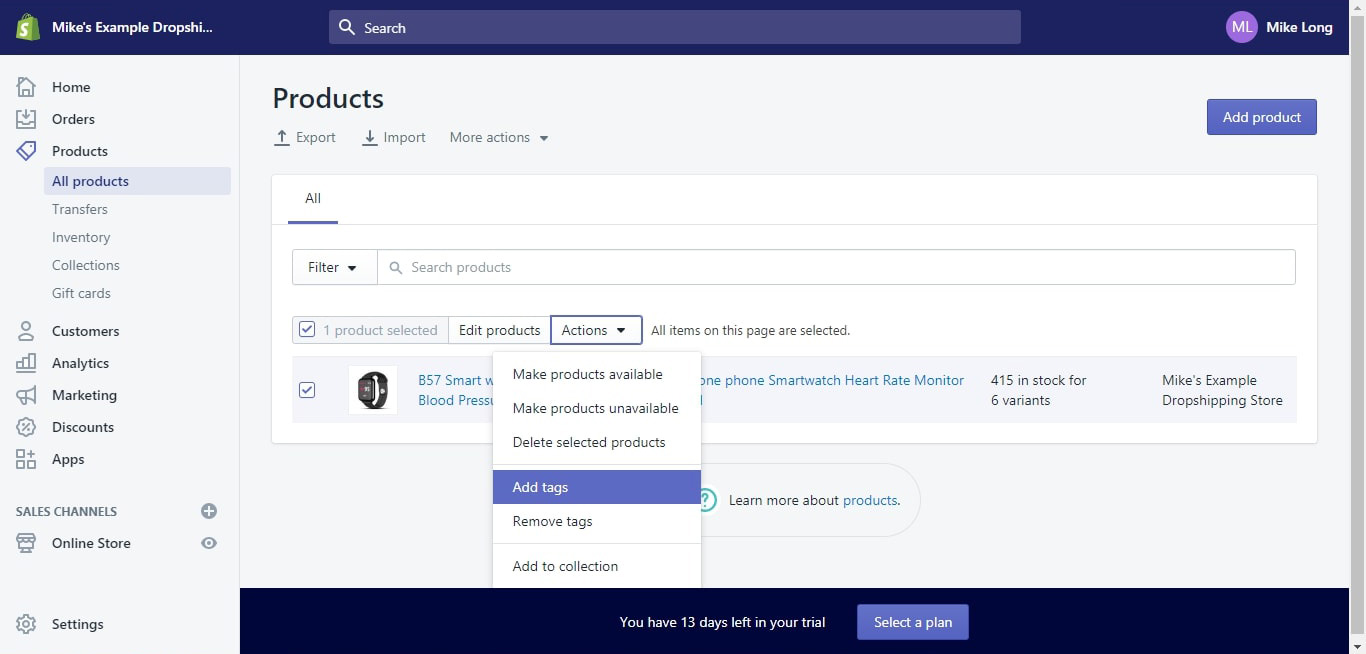
Collections
Collections are just products you can group together based on a variety of factors. Basically you’re just making it simple for customers to look for products according to their type, category, material, make, season etc. For example:
- Product material (leather, metal, wood)
- Product season (Summer, Fall, etc.)
- Product type (wallets, sunglasses, bands)
- Offers and discounted products
To add a collection, all you need to do is click on the “Products” tab on the left hand navigation pane, and then select “Collections”. This will take you to the “Collections” page where you need to click the “Create collection” button. Here you can add your Collection name and a description.
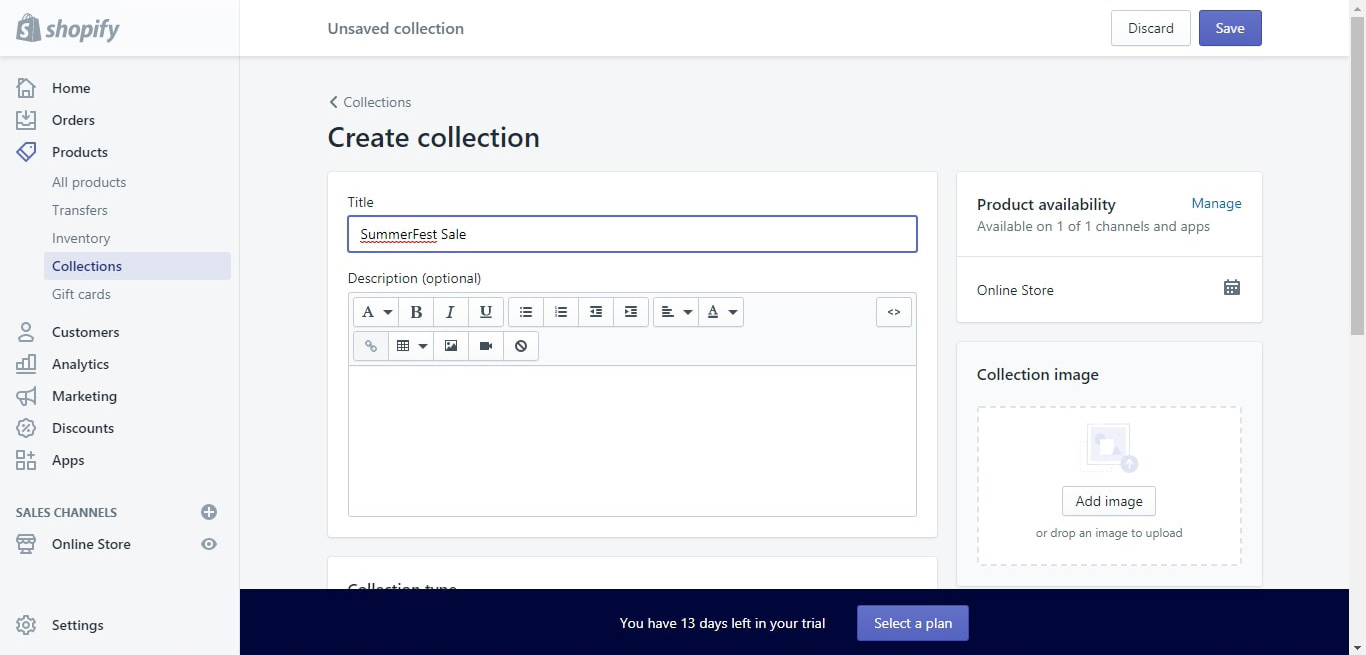
Shopify offers two options that you can use to create collections – manual and automatic. With manual collections, you have to add or remove products individually and the collection will always contain the same products. This option is more time and effort consuming but is great if you want to maintain a small collection.
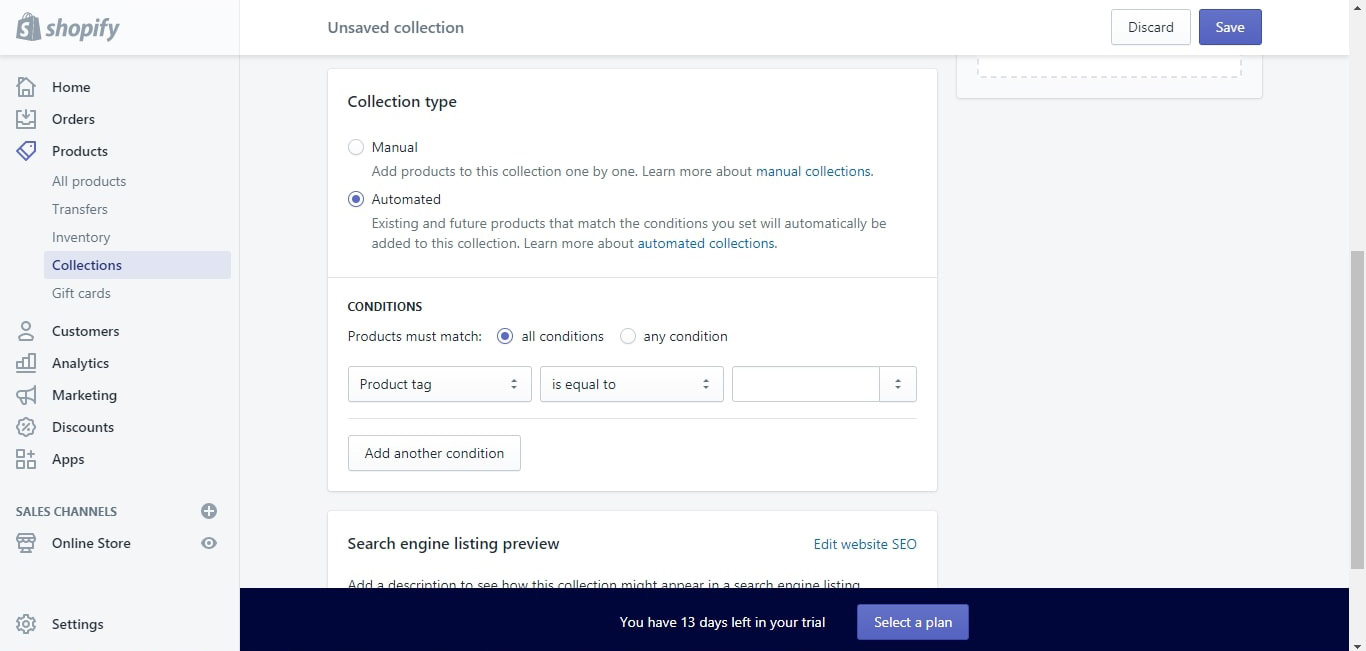
The automatic option on the other hand will automatically add items that have the same tags. For example, any item that has the “Sale” tag will automatically get added to this collection. This makes it super easy and hassle-free for you manage large amounts of products without having to add each individually to any collection.
Remember, there’s no right or wrong way to create and manage collections and you simply have to find out which method works for you.
Step 5: Designing your Store
So far, so good. Now that you’ve added your products and collections, you now begin designing your Shopify dropshipping store. To start, click on the “Online Store” option on the left hand navigation pane and select the “Themes” option. Shopify offers some really great free themes that you can use. On the other hand, if you’ve got the budget, you can explore other options on their marketplace.
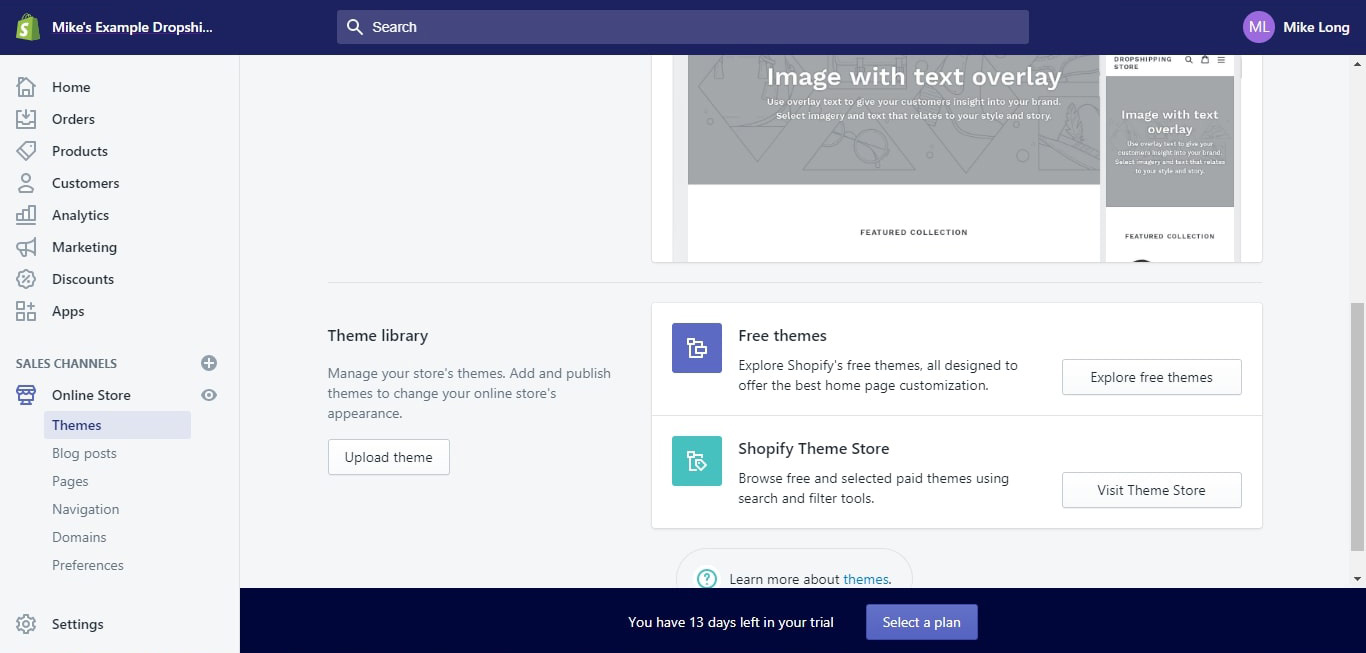
Once you’ve selected the theme you like, you need to get back to the themes section on your dashboard and click the blue “Customize” button.
Customizing your site
The “Customize” button will take you to the theme designer page, where you can tweak how your website looks and feels to your users. You have a lot of options here to change how different aspects of your theme appear and behave. To begin, just go through all of the options on the left hand side navigation pane.
The specific options available to you depend on the theme you’ve chose. Most themes will have a header and this is where you can upload your brand’s logo, resize and reposition it as you like. Some themes have a slideshow option on the homepage, and this is where you can add custom sliders to highlight your products and collections.
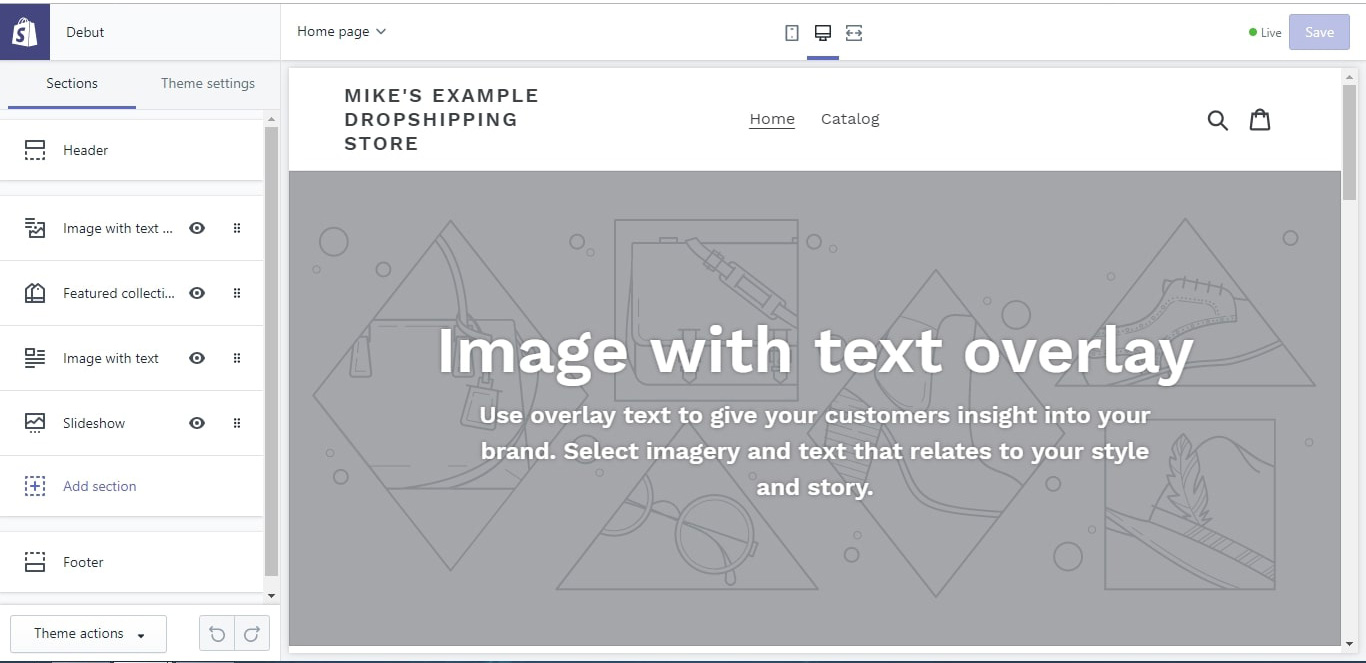
Remember, images are the most important design element on your site. Make sure to add as many great, high quality photos as possible. Just like everything else, adding photos on Shopify is really simple. You can either upload them directly from your computer or use Burst, Shopify’s free stock photo tool.
Other elements that you can customize include the layout, fonts, colors, and social media links on your site. The best way to end up with a great looking dropshipping store is to play around with as many options as possible and pick out what you think looks great.
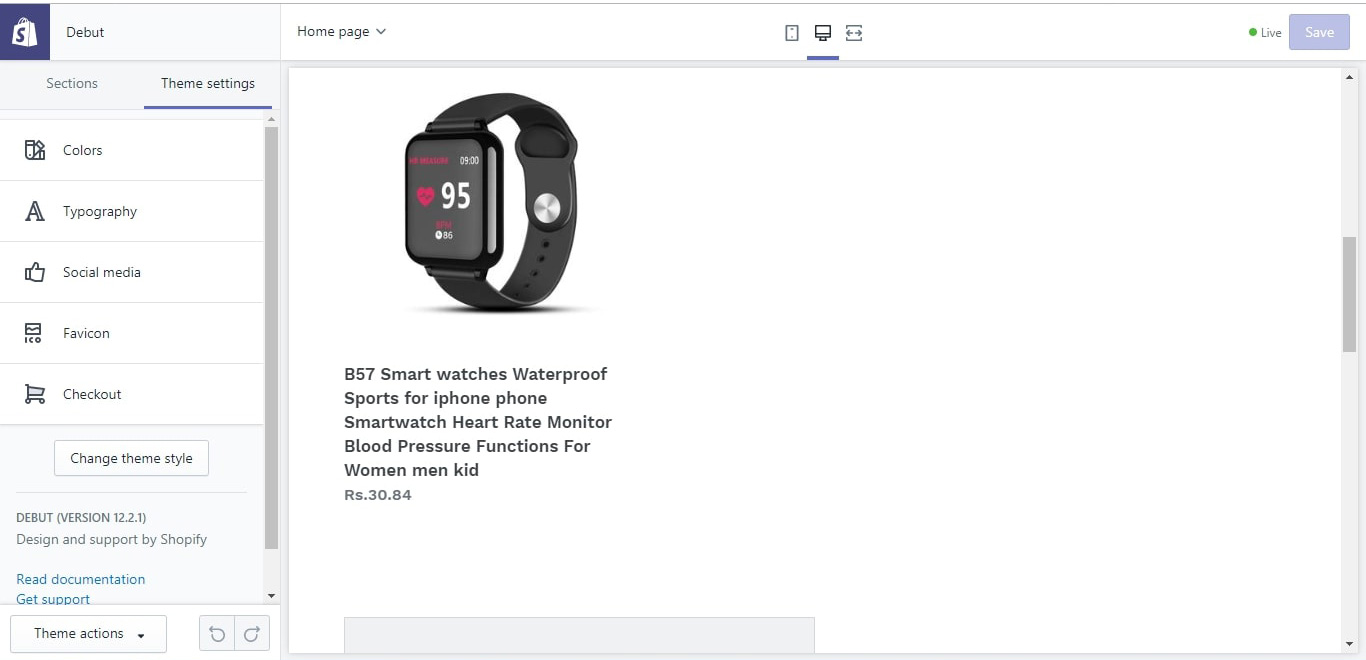
Once you’re done and are happy with the way your site looks and behaves, simply click “Save”!
Step 6: Adding Pages
Now that you have a great looking site, it needs pages. A few examples of the pages you can add include:
- Collections (Sales, Men, Women, etc.)
- About Us Page
- Contact Us
- Shipping and Returns
- FAQs
To add a new page to your site, you need to select the “Pages” link on the left-hand navigation pane and click “Add Page”. This will direct you to a new page form.
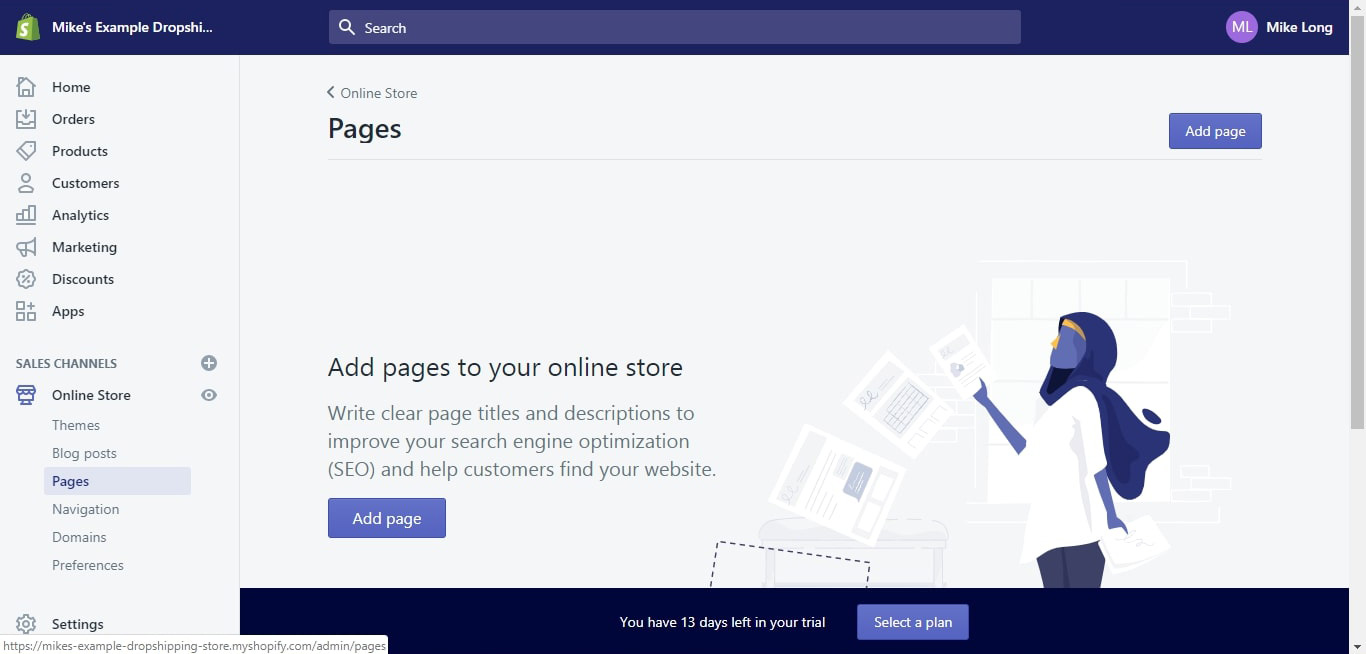
Here, you need to add the title of your page as well as other details such as the meta title, description, and URL. This is especially useful for SEO, because you can easily control what want Google and other search engines to see. Once you’re done, just click Save.
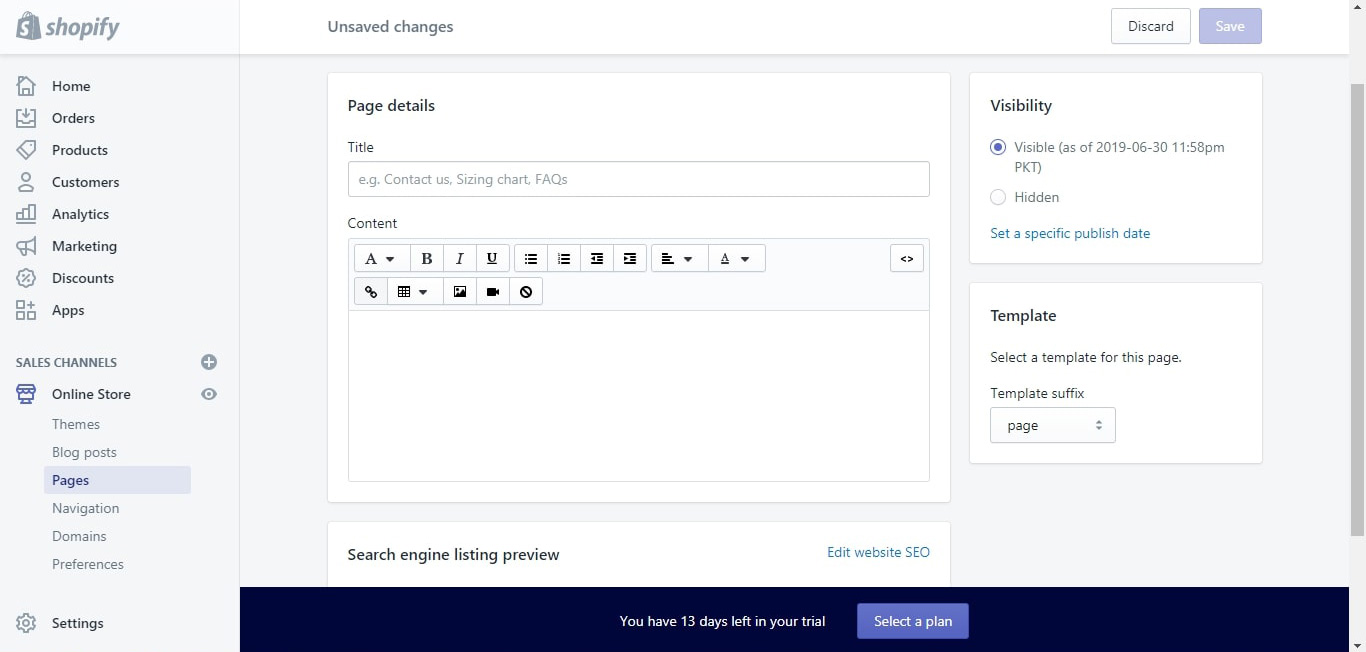
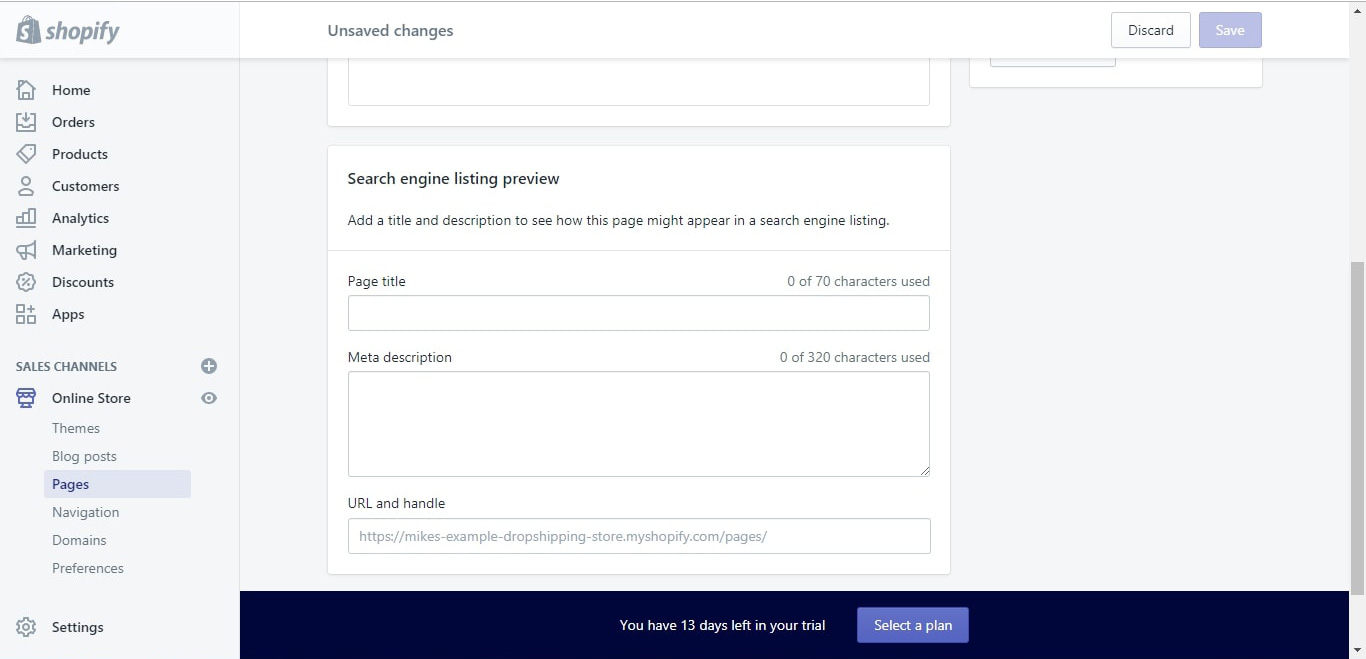
All you have to do next is repeat this process for all pages you want to create.
Step 7: Navigation
Now that you’ve got all your pages set up, you need to set up where and in what order these pages appear on your site menus. This is where you need to set up your site’s navigation.
Before you start, it’s a good idea to sit down with a pen and paper and plan this out. Look at this from both your perspective as well as the customer’s. What information are your customers looking for first? What information would you like them to see as soon as they enter your site?
This is how you can easily decide which pages go on your main menu, and which go elsewhere. A good idea can be to add your collections and the “About us” page on the main menu. Other pages like FAQs and Contact can be placed in the footer. However, you should remember that this is just a recommendation. Each website will have different requirements and you need to think about keeping your business and customers in mind.
Once you have planned it out, select “Navigation” from the left hand navigation pane. Once in the Navigation section, simply select which menu you want to add an item to. For example, the “Footer menu”. Next, click “Add menu item”. Add the name for this menu item and select it from the list of products, collections and pages that you’ve set up. (Now you can see why it was a great idea to add your products and collections beforehand) Simply select the page or collection you want to add in your menu and repeat the process as many times as necessary.
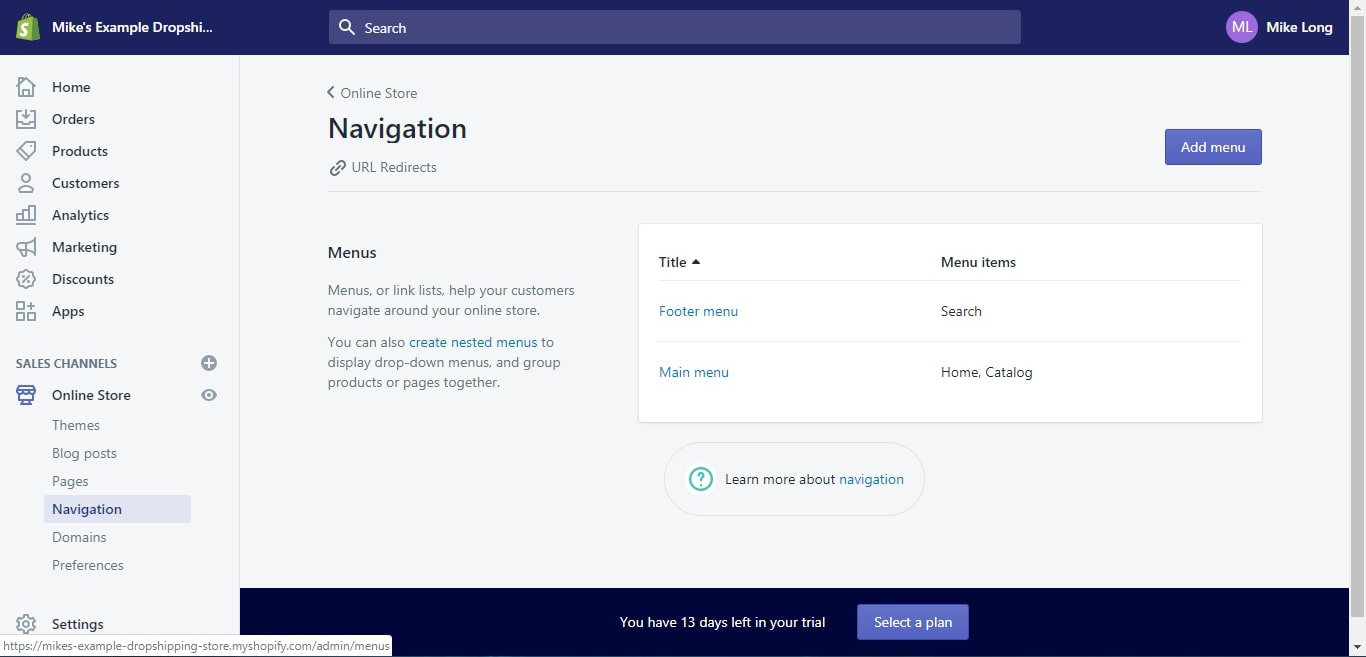
Step 8: General Preferences
Select the “Preferences” tool on the left hand navigation pane on your Shopify dashboard. This is the section where you can add and edit your site’s title and meta description. You can also add your Google Analytics and Facebook Pixel code here.
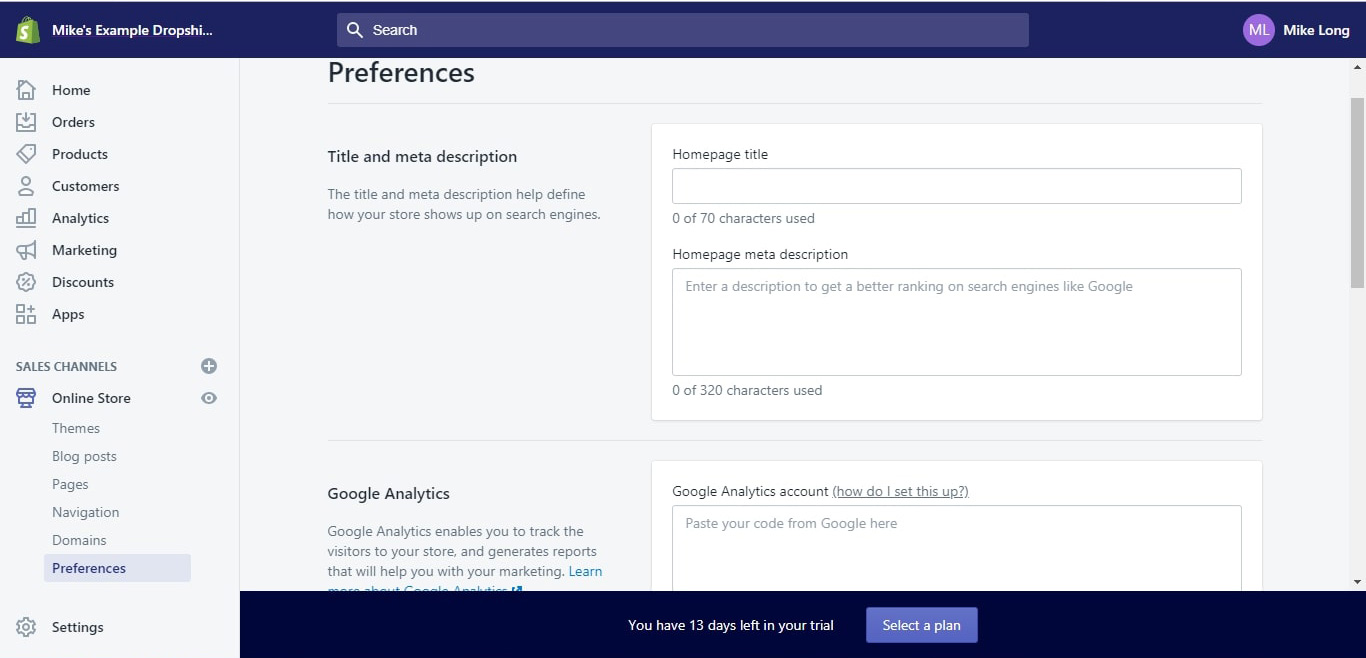
Step 9: Adding a Domain
Done setting up your store? Good job! The next thing on your list should be adding a domain name. Without one, your store will have a URL like this: YOUR-STORE.myShopify.com and that is simply not professional at all.
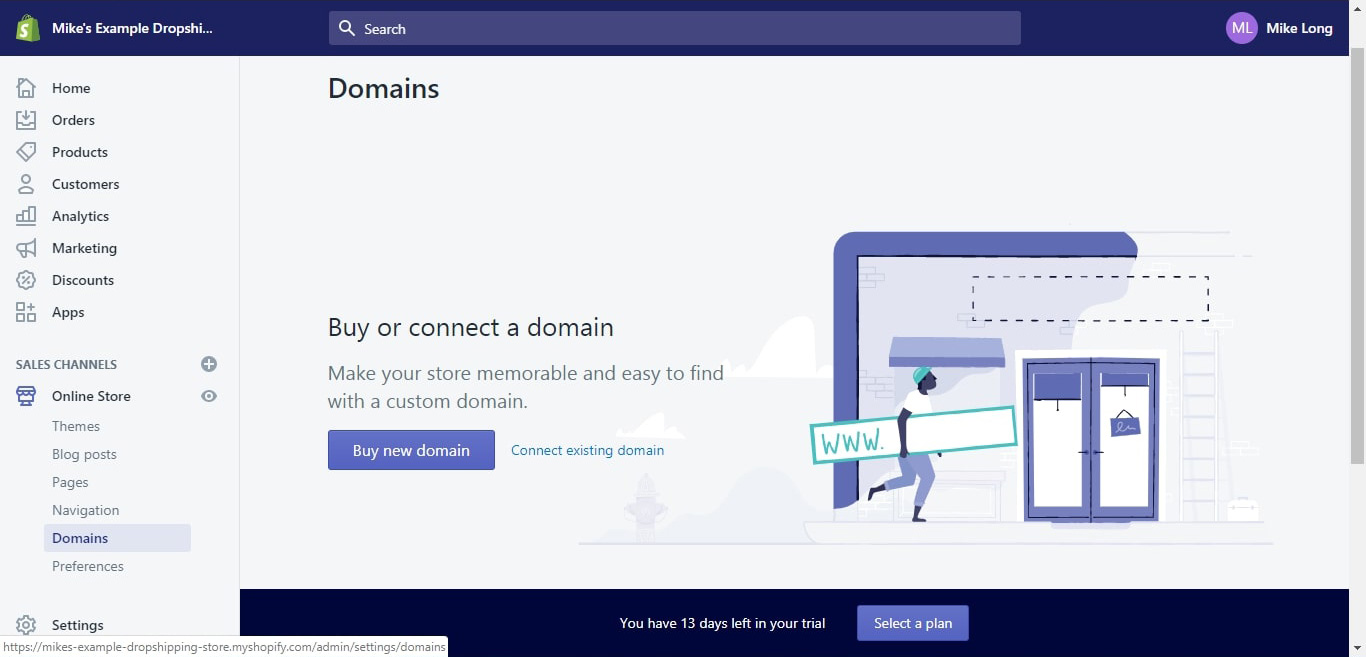
For customers to take you seriously, you need to get rid of this unappealing domain and add a custom one. There’s three ways you can do this. Select “Domain Settings” under the “Online Store” tab on the navigation pane, and choose any of the three options that suits you best.
1. Connect a third party domain to Shopify
If you already own a domain, you can simply connect it to Shopify. This will result in the Shopify system pointing your domain towards your Shopify dropshipping store. How this works will vary depending on your domain provider (GoDaddy, Bluehost, etc.) and you can visit the Shopify help page for more details.
2. Transfer a domain to Shopify
You can also choose to transfer your domain to Shopify so that you can manage and pay for it through Shopify’s back end. However how this works out varies depending on your domain provider so you will have to check with both platforms.
3. Purchase a new domain
If you don’t have a domain, you can simply purchase it through Shopify. The process is really simple and prices start at $11 per year.
Step 10: Setting up Payments
The final thing you need to do is set up payments for your Shopify dropshipping store. Just click on “Settings” in the navigation pane on the left and select “Payment Providers”. This will take you to the Payments page where you can set up and choose your payment providers.
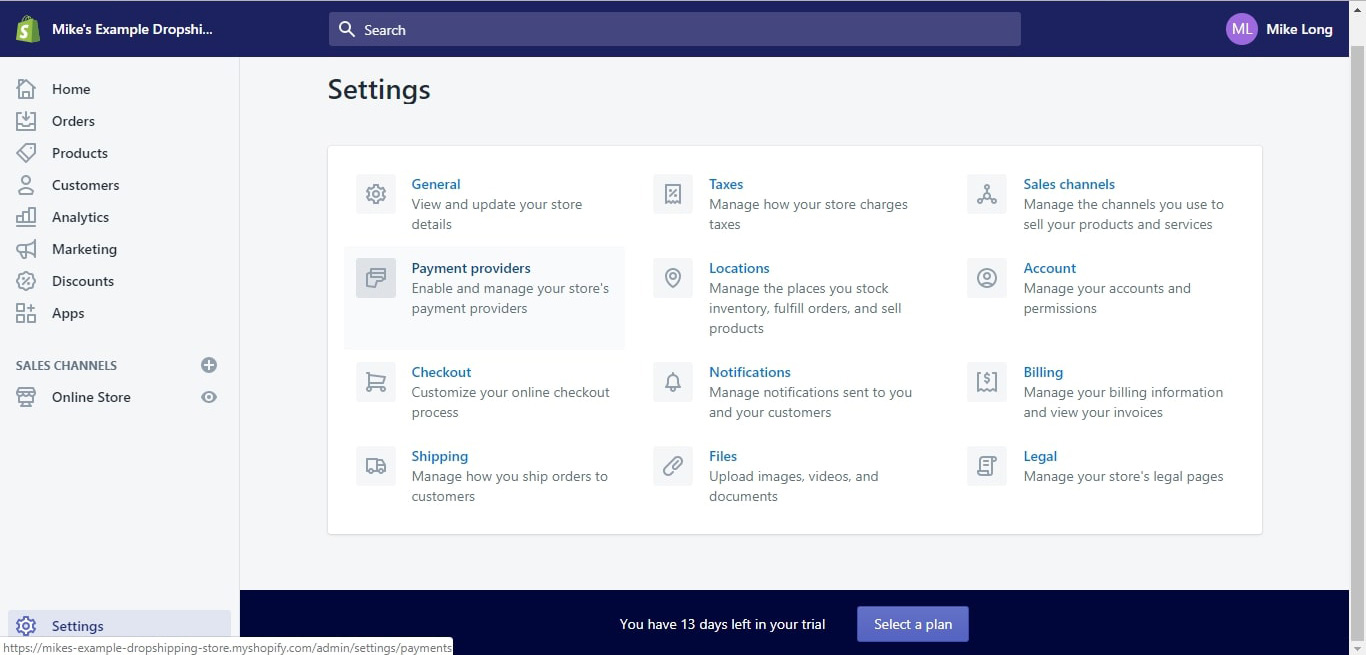
While Shopify Payments and PayPal will probably be enabled by default, you can add other payment options like Amazon Pay, Bitcoin and others right here. The payment process will vary with each payment option but Shopify payments will only transfer your payments to your bank account after you’ve set it up, and provided the details required.
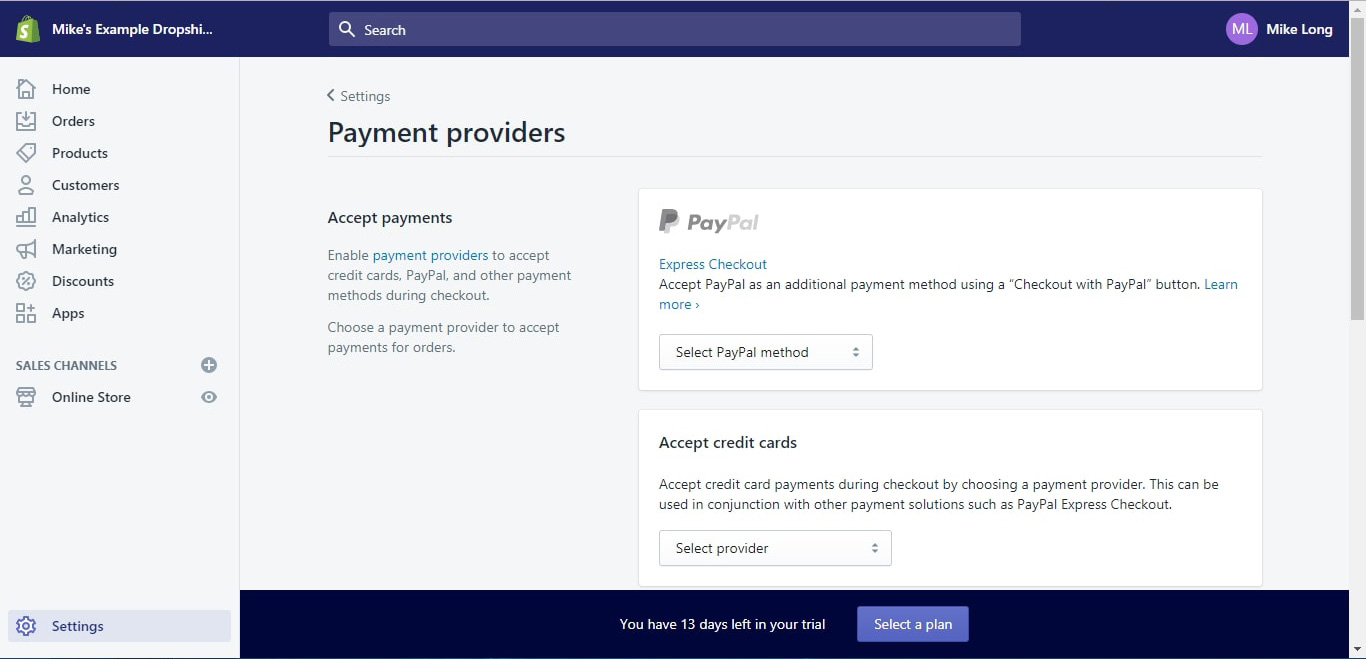
And this is it! Congratulations! You’ve set up your very own Shopify dropshipping store. You now have a basic, almost complete website for your dropshipping business. While this is great, your website is still in its infancy and needs some final touches. Let’s take a look at what you need to do to transform it from a basic store to a full-fledged dropshipping brand.
Exploring Dropshipping companies and Apps for Shopify
While we’ve been using Oberlo as an example, it’s not the only dropshipping app out there. It’s always a good idea to have a variety of products from different platforms so that your site is always well-stocked. Here, we will look at Oberlo and a few other companies that you can source your items from.
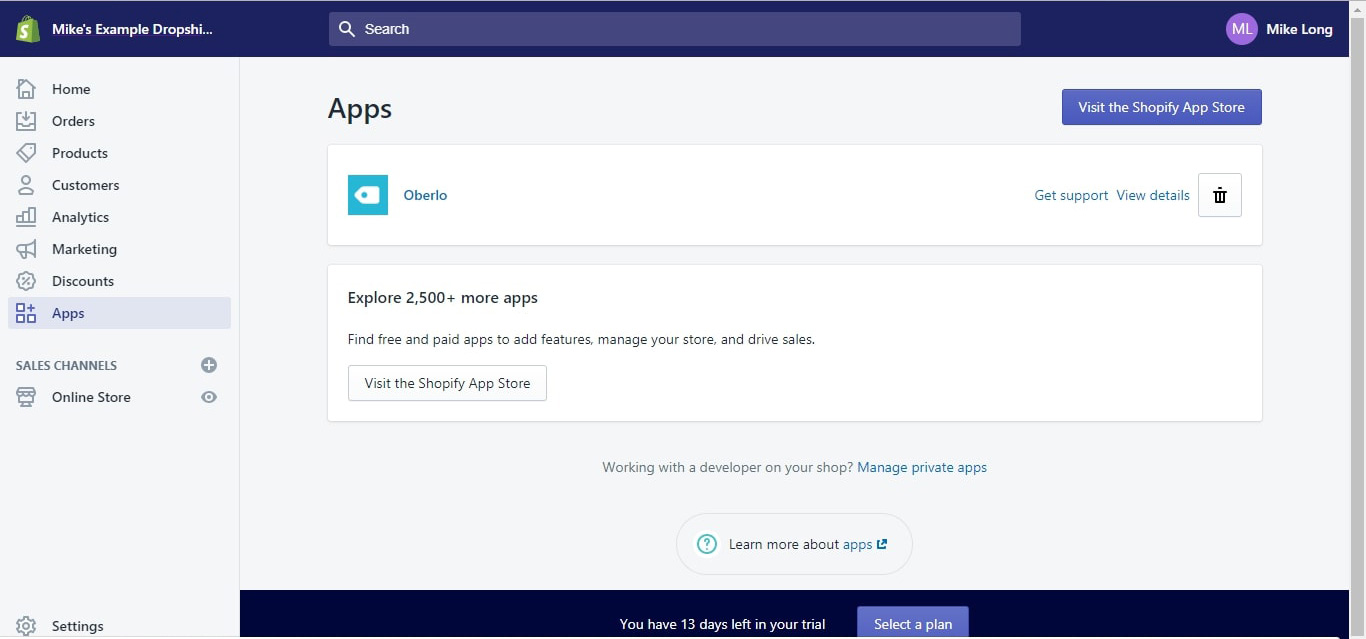
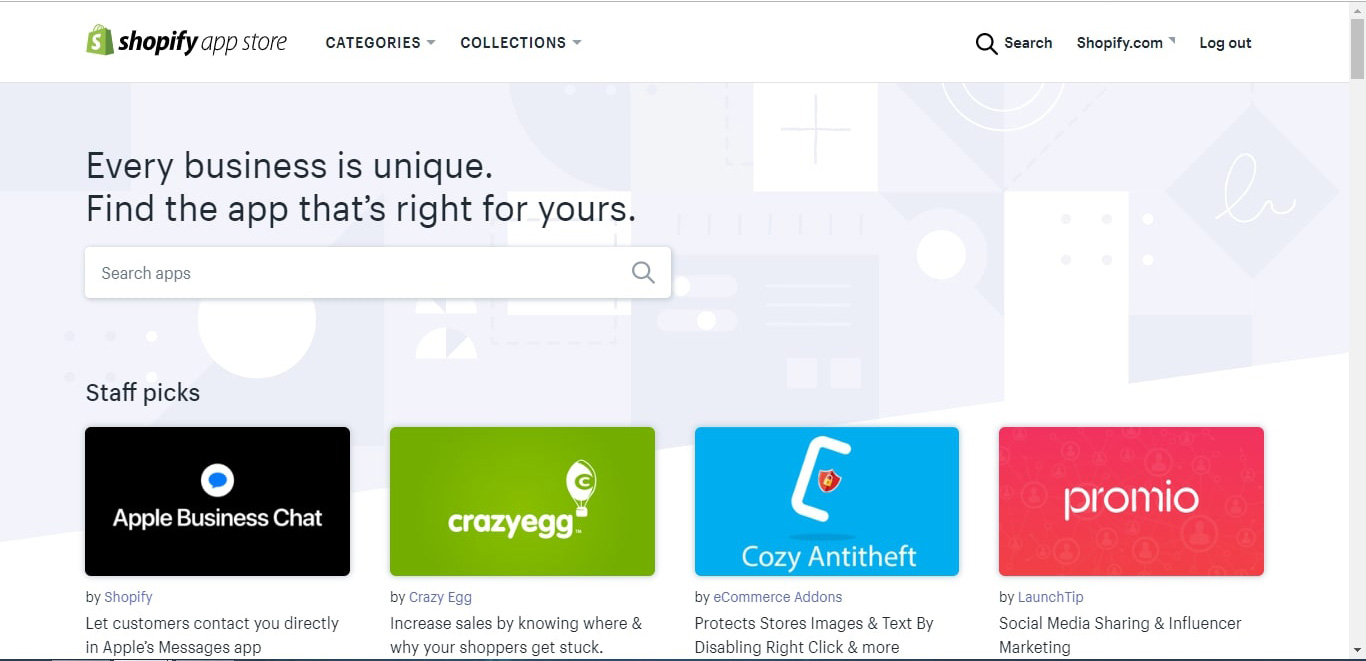
Sell The Trend
Sell The Trend is an all-in-one dropshipping platform that can save you a lot of money, time, and energy. It starts with the AI-Powered Nexus product research machine. You can expect to find hot profitable products with this AI product research tool – even before they hit the market.
Some key features of Sell The Trend includes:
- AI-Powered Product Research Tool
- Store Intelligence Spy
- Video Ads Creator
- Facebook Audience Builder
- Multiple Product Explorers i.e. Amazon, AliExpress, CJDropshipping, Shopify Stores
- Free Dropshipping & Facebook Courses
Hundreds of trending products are added each day on Sell The Trend and people are making thousnads of dollars listing and selling these products on their Shopify stores. Start the free 7-day trial here.
Oberlo
We’ve been using Oberlo as an example for good reason. It is Shopify owned and because of that it offers the most seamless experience possible. Key Oberlo features include:
- Seamless integration
- Order fulfillment handles directly by Oberlo
- Automatic updates on quantities and pricing
- Product customization (name, details, images)
- Shipment tracking
- Multiple user support
Pricing: Oberlo is free if you have 500 products or less and get up to 50 orders per month. For 10000 products and a maximum of 500 monthly orders, you have to pay $29.99 per month, which goes up to $79.90 for 30000 products and unlimited monthly orders.
Printful
If you plan on selling custom prints and merchandise such as custom t-shirts and mugs, Printful is a dropshipping solution that caters specifically to this niche. Key features include:
- No upfront monthly fee or inventory cost
- Seamless Shopify integration
- Easy access to designers and photographers
- A useful mockup generator
- Printful warehousing facility
Pricing: varies according to products
MODALYST
MODALYST specializes in name brands, so if you’re looking to dropship those, they have one of the largest name brand collections out there. Key features include:
- Name brands like Calvin Klein, Diesel, Puma, Lacoste and more.
- Independent brands and Low-Cost Goods
- Centralized product and supplier management
- Customizable item name and descriptions
- Free shipping from some suppliers
Pricing: Free!
Spocket
The biggest advantage Spocket offers dropshippers is sourcing from global suppliers. With this app, you can source products from countries in Europe, Asia and even Africa. Spocket also has a lot of discounted merchandise, making your cut quite a healthy one. Key features include:
- Over one million products from global suppliers
- Fast shipping
- Discounted products for healthy profit margins
- Customized invoicing
- Real time stock updates
Pricing: Free!
Spreadr
Spreadr lets you dropship items available on Amazon for a nice commission on each order. You can simply add products from Amazon using their import feature and customers are routed to Amazon through your website. Key features:
- Simple imports
- Editable item name and description
- Customizable product images
- Bulk import features
- Automatic inventory and pricing updates
Pricing: $5 per month
CollectiveFab
If you want to dropship products in the beauty and fashion niche, then CollectiveFab is the best option out there. They specialize in trendy young women fashion, accessories and beauty products and are based out of California. Key features include:
- More than 3500 products
- Orders shipped directly from CollectiveFab facility
- In-app live chat support
- Quantity updates every 4 hours
Pricing: $29 per month
AliExpress
The AliExpress dropshipping app offers quite a few advantages and is easily integrated with Shopify. Hey features include:
- Search and import functionality
- Semi-automated order fulfilment and processing. All you need to do is click “Order product”, the app will do the rest
- Daily pricing updates
- Chrome extension that can import products while browsing
Pricing: $5 per month for 5000 imports, $10 for 10000 imports, $20 per month for 20000 imports.
These apps are the top options you can choose from but they are by no means the only ones. If you can’t find what you’re looking for on these, then there are many different apps in Shopify’s marketplace that will cater to your exact needs.
Choosing your Shopify subscription plan
While the 14-day trial will let you create your Shopify dropshipping store, you won’t be able to actually sell anything until you subscribe to a paid monthly plan.
To officially open your dropshipping store, just click on the “Select a plan” button at the bottom on the left hand navigation pane. Shopify offers users three different plans to choose from.
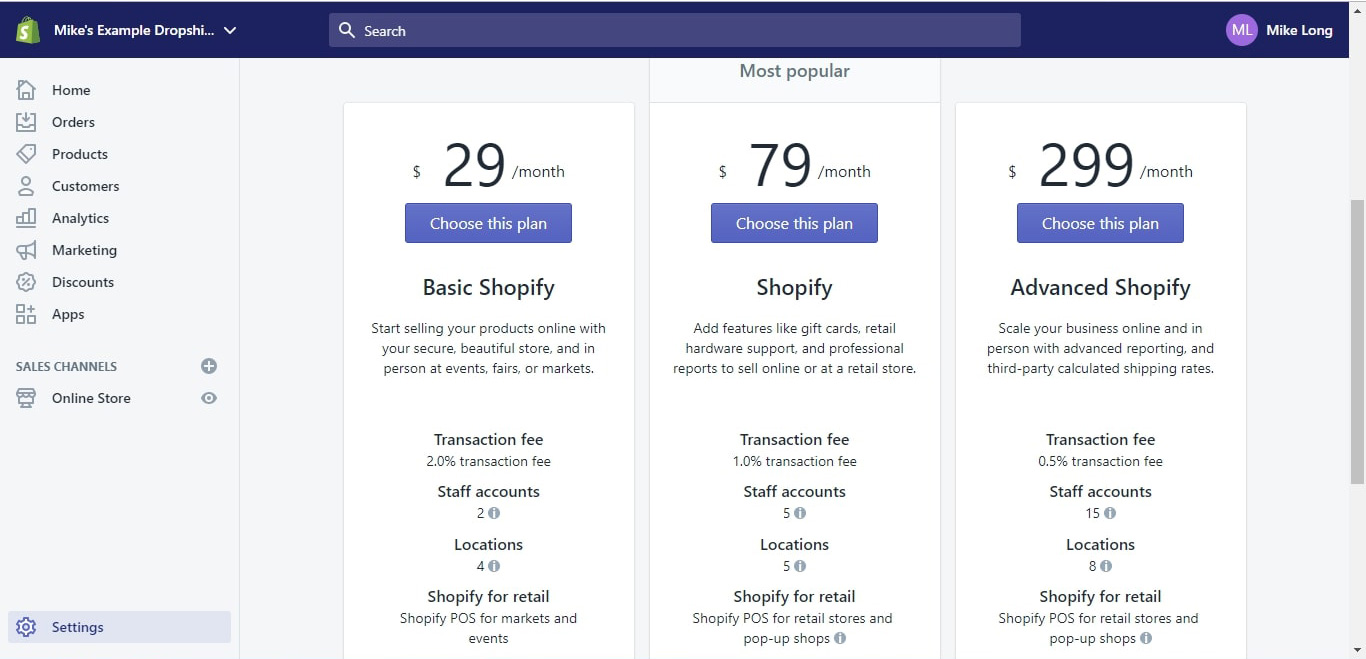
While their “Shopify” plan is the most popular one, you should make a decision based on what your budget and finances look like. And that’s it. Once you select a payment option, you will have officially entered the dropshipping market and will be all set to start making sales!
Shopify Dropshipping Inspiration
This section in our guide is meant to be an inspiration for what your dropshipping business could become. Here, we will look at a few Shopify dropshipping success stories that you can learn and gain motivation from.
Classic Dad
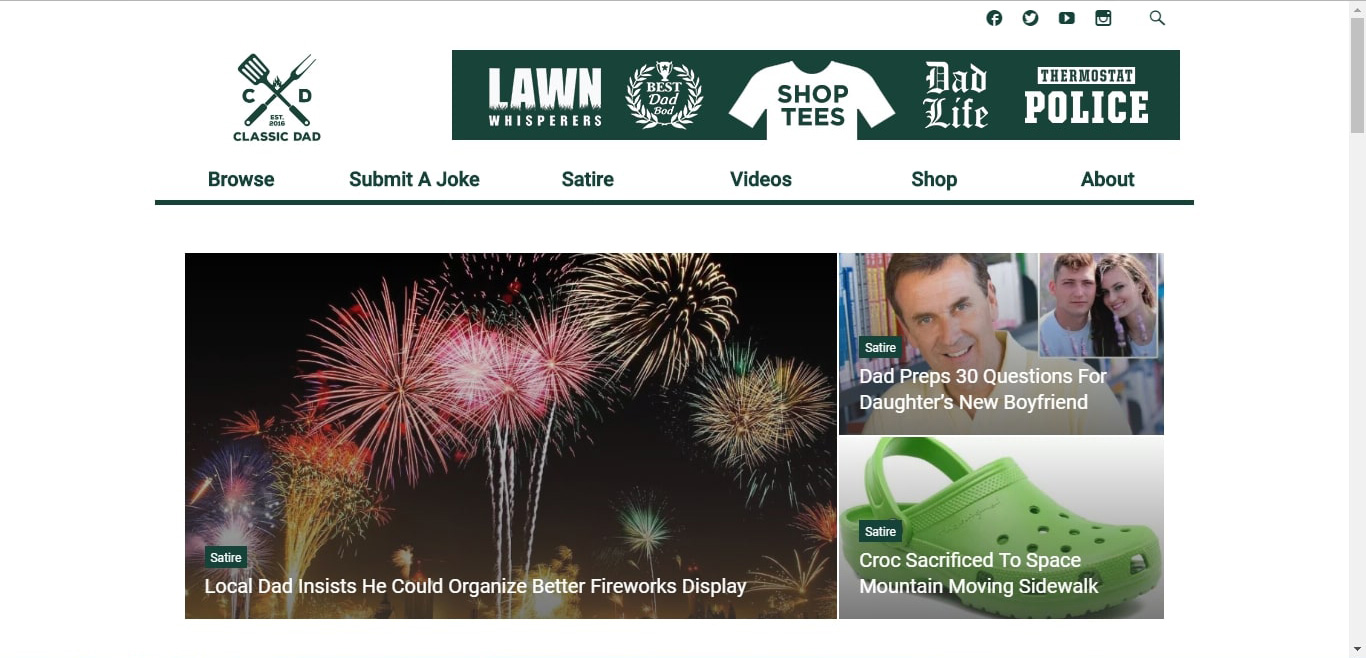
Founded and run by a dad who as a kid who used to get a lot of typical dad jokes from his father, Classic Dad is a great example of a Shopify success story. The store started as a fun Facebook page that uploaded some classic dad jokes, but when the owner Daniel Stone kept getting requests for merchandise, he decided to do something about it.
Daniel found Printful in the Shopify App Store and that’s when it took off. Classic Dad made full use of the various features that both platforms offer and is now a top-selling site that dropships T-shirts with classic dad jokes printed on them.
“Printful gave us a good ability to test designs without doing a massive, print-run commitment.” Daniel Stone – Classic Dad
Crush Case
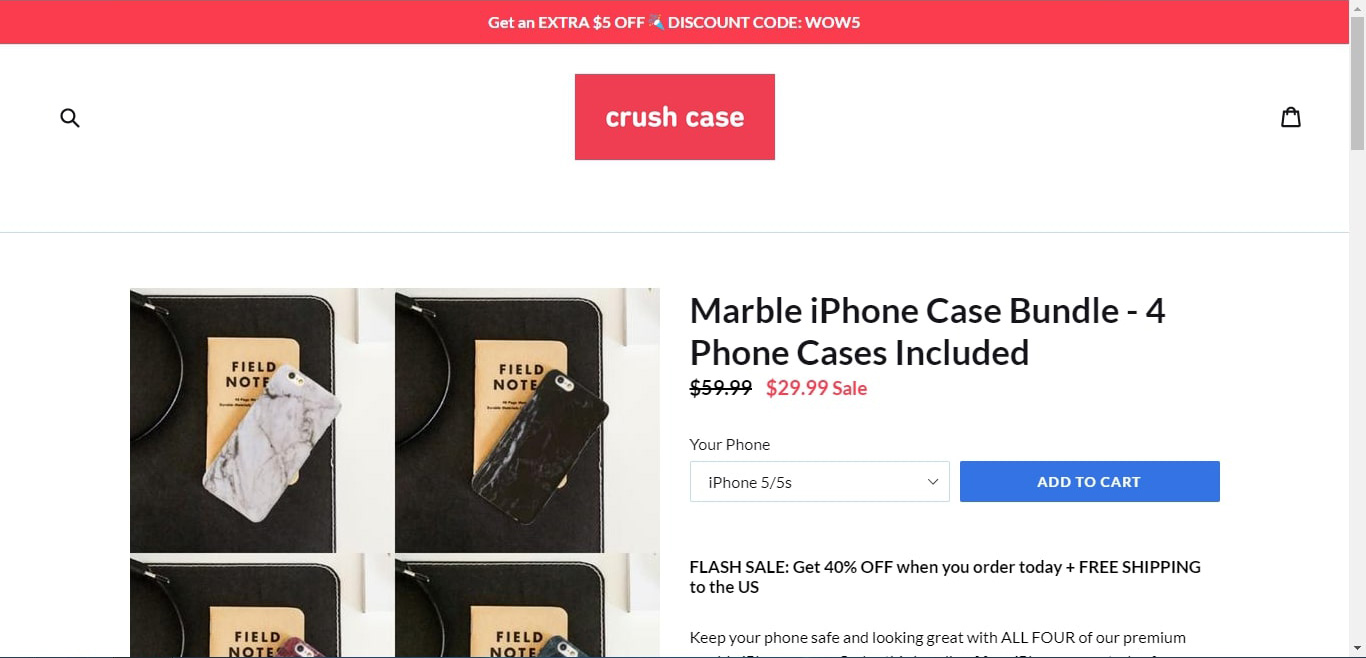
Ray Bridges started this Shopify dropshipping store back in 2018 and made $4558 in the first 9 weeks selling phone cases! Specifically, marble phone cases. Crush Case is unique in the sense that Ray did not start the store around a specific niche, but a single product. He was already looking for products to dropship but the idea for marble phone cases struck him when he observed a rising trend for marble textured laptop skins and furniture.
I scrambled to boot up Google Trends and search for “marble phone cases”. There was a huge trend for “marble phone cases” on the rise. Ray told Oberlo in an interview.
Ray chose Oberlo to find suppliers because he loved the ease and simplicity it offered.
Dropshipping with Oberlo is a simple enough concept. Find a product you want to carry, import it into your store, and—when a customer places an order— process the order directly in the app in one click. Boom. You’ve got yourself a dropshipping business.
He found a supplier, designed his Shopify page, ran ads on social media, and as a nice way of getting more customers, put up all his products on sale permanently. Needless to say, his marble phone cases were an instant phenomenon earning him almost $5000 in the first three months!
Shopify Dropshipping FAQs
As you can see, dropshipping with Shopify is as simple as it gets. The purpose of this guide is to answer as many of your questions about your first Shopify dropshipping store as possible. The FAQs below will help answer any queries that you might still have.
1. Do you need a business license to dropship on Shopify?
The short answer is no. However since you can dropship a lot of different kinds of products, the regulations for each might vary depending on where you live. Some countries and states might require you to have a resalelicense if your products are being sourced from a wholesale distributor.
2. Is Shopify dropshipping legit?
Yes, dropshipping with Shopify is 100% legit. This is because you’re selling products the same way that brick and mortar stores sell products. You work with real companies and major brands who would certainly not work with you if dropshipping was not legit. As one of the largest ecommerce platforms out there, Shopify has a lot of trust in the market.
3. How to automate dropshipping on Shopify?
Shopify is the best platform to automate your dropshipping store. This is because you can use apps like Shopify’s own Oberlo, Printful, Conversio and others, you can automate your entire process from sourcing products to generating sales and even providing customer support!
4. Is Shopify dropshipping dead?
Shopify dropshipping is far from dead. With more than half a million entrepreneurs using it, Shopify is the number one platform for creating your own dropshipping business. The last two years have seen a steady growth in startups based completely on the dropshipping model.
5. Can you make money dropshipping with Shopify?
Yes, there are hundreds of thousands of entrepreneurs out there creating and running successful, profitable dropshipping stores on Shopify. You can take a look at all of these inspiring case studies of successful dropshipping stores here!
6. How to dropship on Amazon using Shopify?
Spreadr is an app in the Shopify app store that lets you sell any item from Amazon on commission. Spreadr simply lets you import the products you want to sell on your site and it even offers automatic inventory and pricing updates so that you don’t end up selling anything that’s not available.
In Conclusion
As you now know, starting your own dropshipping business with Shopify is incredibly simple, and does away with the need for a large up-front investment. All you need to do now is to identify a couple of great niches and markets to explore and follow this ultimate guide to set up your own Shopify dropshipping store. Remember, if you do your research right, it is only a matter of time before you start making big profits.
You can also streamline your product research and marketing tactics with Sell The Trends AI-powered tools. Learn more here. Good luck!






